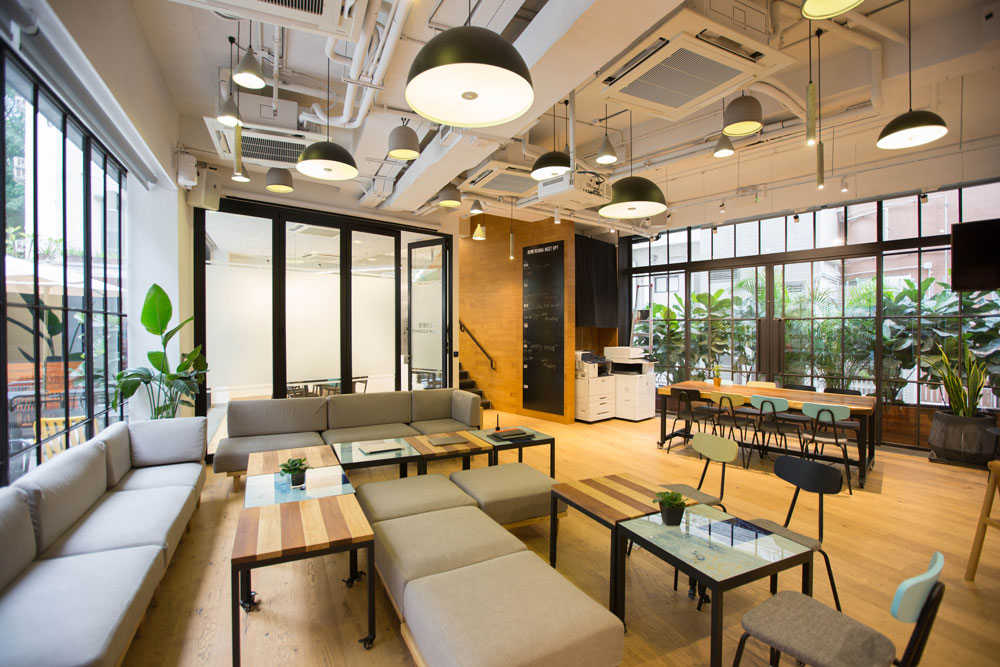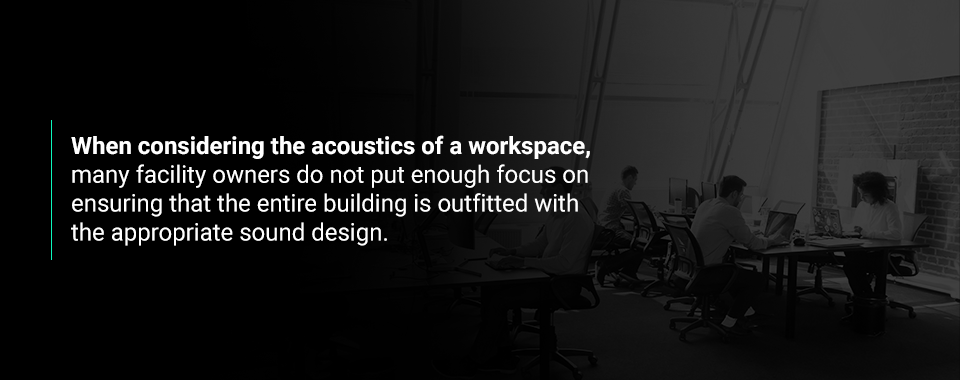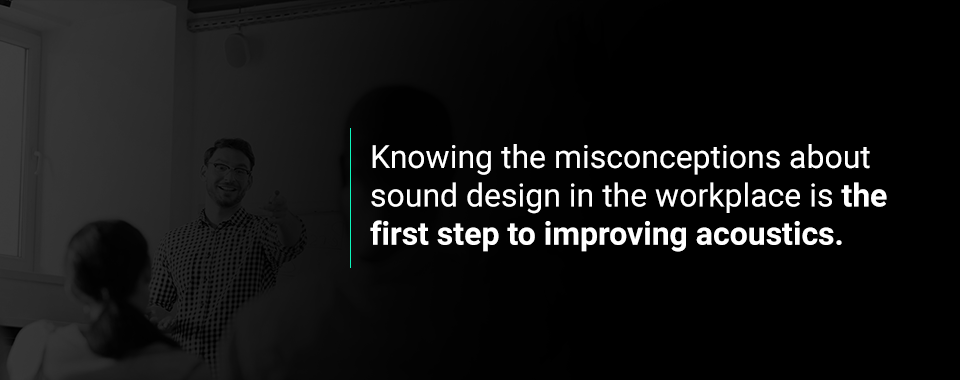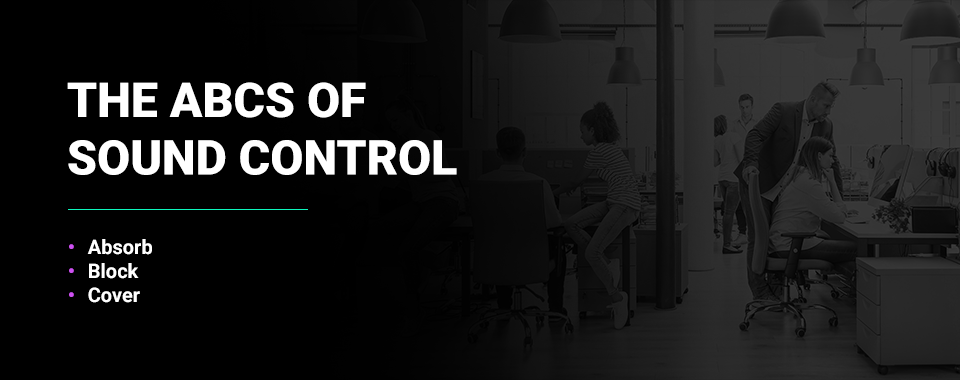

The design of your workplace is just as essential to the success of your business as the productivity of your employees. Technology and dedicated workspaces are fantastic resources, but their effectiveness can be limited by distracting sounds and poor acoustics. Acoustics are important aspects of every workplace, and properly controlling sound should be a top priority for facility managers.
At Illuminated Integration, we believe your workplace should be the ideal setting for your employees to thrive. By ensuring your employee’s spaces possess appropriate acoustics, you can provide them with an effective environment to complete their work.
We live in a world that stimulates our senses in a variety of ways. Our senses take in 11 million bits of information every second from the environment around us. Our ears alone take in 100,000 bits of information per second. With so much noise present in our daily lives, it’s important to understand why the acoustics of a workspace influence our ability to process these sounds.
Have you ever noticed some people can get lost in a book, even when there’s a lot of noise around them, while others need near-silence when they’re concentrating on studying or writing? Depending on the activity you’re engaging in, and how you apply your focus, the amount of information transmitted to our senses is processed in varying degrees. While some people are visual or kinesthetic learners, others rely on auditory cues to retain information. Any employees that rely on auditory cues will rely on available acoustics.
The acoustics of a workplace are important because they can hinder or help us process sensory information. A workspace that’s too quiet can be as distracting as a workplace that’s too loud. Sound influences our productivity and wellness. The structures and furnishings within an office can be modified to help your employees concentrate or diffuse noise to maximize performance. Without taking the time to outfit your offices and workspaces with the right acoustics, you can almost hear productivity being silenced.

When considering the acoustics of a workspace, many facility owners do not put enough focus on ensuring that the entire building is outfitted with the appropriate sound design. This is especially true in the construction or renovation of a space. Priority is typically set on high-profile areas, like meeting rooms or executive offices, and facility managers refrain from integrating the appropriate sound design throughout the space, opting to retrofit it later, should it be deemed necessary.
Acoustic requirements for offices are far more extensive than they seem. Certain sound design elements that may seem intuitive aren’t necessarily effective. One example is the construction of partitions. Many believe if a barrier obstructs visibility, then it can also prevent sound transmission. Many partitions block sound poorly and can actually cause a space to become louder. Similarly, many mistakenly believe that any door will adequately block sound.
The materials and construction strategy used in sound design for offices will have the most positive or negative impact on acoustics. For instance, lower partitions can block sound more effectively than higher partitions, especially if the floor, wall and ceiling materials absorb sound adequately. The same applies to doors — doors with insulated cores and hinges will block sound better than sliding glass doors. Knowing which materials are required to enhance office acoustics will help you achieve an effective sound design without costly mistakes.
Open office workspaces continue to be a popular trend in many industries. While open floor plans can increase a sense of community, cross-department collaboration and a more fluid dynamic, larger spaces don’t normally increase the speech privacy for employees. Even in the largest of settings in which employees are spread out across a wide floor plan, noise from one area can fill the entire space. Often, it’s necessary to integrate elements into the space that either absorb, block or cover surrounding sound, such as white-noise emitters.
Along with open offices, there’s also a trend for workspaces to feature more natural light. While the inclusion of more transparent and translucent walls increases daylighting initiatives, some facility owners misbelieve that their buildings cannot integrate acoustic elements into their structure. Thankfully, new developments in sound design have led to the creation of sustainable products and applications that can integrate open office acoustics in virtually any space. From carpeting to ceiling tiles, you can outfit your open spaces to maximize daylight, while limiting external and internal noise.
Another major misconception about open office acoustics is that it’s an expensive endeavor, regardless if it’s being integrated into new construction or during a renovation. While it is true that, in the long run, incorrectly attempting to integrate acoustics into the workplace can be a costly endeavor, improving the sound design of your workspaces does not need to be expensive. Specialized services, like those offered by Illuminated Integration, can accurately and affordably enhance acoustics in the workplace, while working with any budget.

Knowing the misconceptions about sound design in the workplace is the first step to improving acoustics. The next step is to identify the sources of disruptive sounds and determine how they should be controlled. You’ll need to examine both internal and external noises, understanding that some of these sounds can be better controlled than others. The key to controlling sound in both contexts is knowing when it is appropriate to use materials that absorb, block or cover sound intrusion.
Take a moment to sit and listen — what do you hear? When you’re in your office, what sounds penetrate your walls? Observe your employees in their various works areas and take note of the noises filling the space. Machines, people and the external environment can create a symphony of distractions or a chorus of inspiration. Knowing which internal and external sounds help your employees, and how to control those that hinder them, can cultivate an ideal atmosphere for you and your team.
There are four different types of sounds you may want to control — continuous, intermittent, impulsive and low-frequency noise. Different tools are used to measure each noise and will help you determine which method of sound control you can use to lessen these potentially disruptive sources. All four types of noises could come from internal and external sources.
Internal office noise is quite unpredictable. Verbal communication is only a small contributor to the sounds that regularly fill a workspace. Especially in offices that feature open spaces, the daily sounds of typing, printing and walking can become quite distracting to employees. Of the many internal sounds around the workplace, they may also include:
External noises can be unpredictable and disruptive, and they’re often much more difficult to control than internal noises. For instance, old machinery that naturally operates at a loud volume could be replaced. Employees could also be encouraged to keep their volume lower when congregating in certain areas. However, you cannot control how many cars drive by your workplace or how loud people speak on the floors above or below yours. External noises emanating from outside may include:
It’s also important to consider internal and external noise in the way they affect individual personalities and mental struggles. For example, someone suffering from health issues like headaches may be more afflicted by loud noises like nearby construction work. Another instance could be when an individual is cognitively distracted by personal issues — their focus may be hindered even more by the presence of internal office noises like rattling ventilation, beeping machines or the sounds of their coworkers.

How can you control sound in your workspaces? It’s as easy as ABC — absorb, block and cover. These three sound design features can be used independently or collaboratively, depending on the context. For instance, an office that’s being renovated may only require sound-absorbing materials to prevent noise from leaving the space, while the new construction of a communal workspace may require materials that absorb and block noise, plus the introduction of a sound-masking system to cover noise.
Noise is inevitable in the workplace. Although it can be controlled to an extent, employees that share workspaces with small or large groups of their peers will eventually be distracted by internal and external disruptions. Noise levels and reverberation can be controlled with sound-absorbing materials. These resources are ideal for secluded areas and open office acoustics. Ceiling tiles, wall partitions, carpeting and insulation can be added throughout a space to reduce noise. Even decor, plants and furnishings can absorb disruptive noise.
Two of the best opportunities an organization has for integrating sound-absorbing materials throughout its structure are when renovations are being completed and during new construction. Investing in sound-absorbing materials and integrating them into the project during its initial design is a cost-effective way to accurately enhance the acoustics of specific areas without a need for further modification later.
Not all workspaces prioritize quietness. In fact, there are many contexts in which constant communication, collaboration and noise are highly desired. When you’re considering acoustic requirements for offices that contain areas that require both silence and the ability to sound-off without issue, you need resources that will do more than simply absorb sound. You need to provide as much sound blockage as possible. Sound blocking prevents the spread of noises from area to area. There are two ways you can effectively block internal and external sounds.
One approach is to create dedicated spaces for quietness within your building. These spaces can be outfitted with materials that prevent the transmission of noise from entering or leaving an area. In the opposite sense, you could also create rooms specifically for louder activities to take place, outfitting it with sound-blocking materials to not disturb surrounding areas. Another approach is to integrate sound-blocking materials into the building’s structure to prevent external sounds from penetrating inside.
What if the design or operations of your business prevents you from integrating elements that absorb or block sound adequately? You always have a third option — masking the sound with another noise. This is also a viable solution for workspaces that are distractingly quiet, as well. In terms of sound design, covering refers to the act of controlling background noise via a sound-masking system. By covering the presence or lack of sound, you can create a more appealing workplace.
One of the most common complaints when it comes to noise in the workplace is the conversations of fellow employees. Even at low levels, these sounds can be significantly distracting, especially when coupled with the other internal noises produced throughout the office. One way to fill a space with volume-appropriate noise is to use a sound-making system with loudspeakers installed throughout the space. These systems must uniformly distribute the sound across the entire space at the appropriate volume level.
Ideally, the noises emitting from the sound-making system will be on a middle frequency that resembles the sound of moving air or water. Covering can also mask the sound of external noise pollution. These ambient sounds, coupled with soundproofing materials that reduce the presence of external noise, can prevent employees from being distracted by the continuous or intermittent noises occurring outside the building.
What do efficiency and productivity sound like in the workplace? In some contexts, it’s buzzing like a beehive as your teams collaborate and conquer company goals. In others, it’s a measured level of noise that’s neither unnerving or distracting. Don’t disrupt your business with needless internal and external noises. Let Illuminated Integration help you achieve ideal sound design throughout your offices. Whether you’re building a new facility, renovating a few offices or updating workspaces, our years of experience and knowledge of sound design can help you achieve your goals.
Contact us today to learn more about the ways Illuminated Integration can enhance the acoustics in your current or future workspaces.